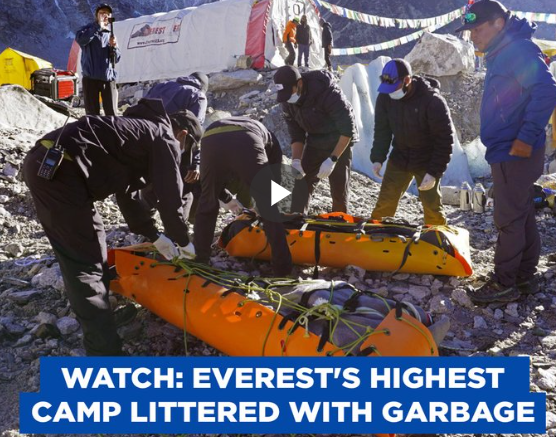What a mess we make on top of the world’s tallest mountain…
The maximum camp on the world’s tallest mountain, Mount Everest, is stressed with a surprising amount of rubbish in an effort to take years to clear, in step with a Sherpa who currently led a cleanup attempt. Ang Babu Sherpa spearheaded a crew funded by the Nepal authorities, comprising soldiers and Sherpas, to take away eleven heaps of rubbish, four bodies, and a skeleton during this 12 months’s mountain climbing season.
Everest’s highest camp appears covered with frozen garbage, cleaning up which could take years, Nepal govt says pic.twitter.com/sl00AdnUjG
— RT (@RT_com) July 7, 2024
Ang Babu Sherpa discovered that there may be an expected forty-50 lots of waste nonetheless ultimate at South Col, the last camp before climbers try the summit. “The trash left there includes antique tents, meals packaging, fuel cartridges, oxygen bottles, tent packs, and ropes,” he defined. This debris is layered and frozen at the high altitude of 8,000 meters (26,400 ft), making it distinctly hard to dispose of.
Mount Everest has been a famous mountaineering destination since it turned into first conquered in 1953. Over the a long time, thousands of climbers have left behind great quantities of waste. While current policies require climbers to bring returned their rubbish or forfeit their deposits, hence elevating environmental focus, in advance expeditions did no longer adhere to such requirements. Consequently, a lot of the present waste originates from those in advance climbs.
The cleanup operation was a big effort, with Sherpas tackling better altitude regions and infantrymen running at decrease levels and the bottom camp. Ang Babu highlighted the severa challenges confronted, specially because of harsh climate conditions. The South Col location, with its low oxygen degrees, unpredictable blizzards, and frigid temperatures, posed giant limitations. “We had to await favorable climate situations when the sun would soften the ice cover, but waiting too lengthy in such situations isn’t always viable,” he stated.
Everest is littered with frozen debris and dead bodies , – AP News.
A group of soldiers, funded by the Nepalese government, removed 11 tons of garbage, four corpses and a skeleton from the mountain during the climbing season.
Old tents, food wrappers, gas and oxygen cylinders,… pic.twitter.com/CDUePLSvYT
— Peacemaker (@peacemaket71) July 7, 2024
Excavating the garbage become labor-intensive, because the gadgets were often frozen in ice, requiring full-size effort to break free. One frame, frozen in a status position close to South Col, took two days to extract. The crew had to retreat to lower camps because of worsening climate earlier than resuming their efforts. Another body, positioned even higher at 8,four hundred meters (27,720 ft), took 18 hours to drag all the way down to Camp 2, wherein it was airlifted through helicopter.
The recovered our bodies had been transported to Tribhuvan University Teaching Hospital in Kathmandu for identification. Of the 11 lots of garbage removed, three lots of decomposable items were taken to close by villages, at the same time as the ultimate eight lots were carried by way of porters and yaks, then transported via vans to Kathmandu. There, it was looked after for recycling with the aid of Agni Ventures, an business enterprise that specialize in recyclable waste management.
Sushil Khadga of Agni Ventures noted, “The oldest waste we obtained was from 1957, including rechargeable batteries for torch lights.” This highlights the iconic hassle of waste left behind with the aid of climbers over the decades.
Addressing the reasons why climbers depart rubbish, Khadga explained, “At that excessive altitude, lifestyles is extremely difficult, and oxygen stages are very low. Climbers and their helpers are broadly speaking focused on survival, which regularly results in the abandonment of gear and waste.”
Everest’s Highest Camp Littered With Frozen Garbage | WATCH#TNSHORTS #MountEverest pic.twitter.com/BXRf2D39UX
— TIMES NOW (@TimesNow) July 6, 2024
Major Points:
- A Nepal government-funded team, led by Ang Babu Sherpa, removed 11 tons of garbage, four bodies, and a skeleton from Mount Everest during this year’s climbing season.
- An estimated 40-50 tons of waste still remain at South Col, the last camp before the summit, primarily consisting of old tents, food packaging, gas cartridges, oxygen bottles, and ropes.
- Harsh weather conditions, low oxygen levels, and frozen waste posed significant challenges for the cleanup team.
- The cleanup included transporting decomposable items to nearby villages and eight tons of other waste to Kathmandu for recycling by Agni Ventures.
- The enduring problem of waste on Everest stems from earlier expeditions, with modern regulations now requiring climbers to bring back their garbage.
Kirk Volo – Reprinted with permission of Whatfinger News



